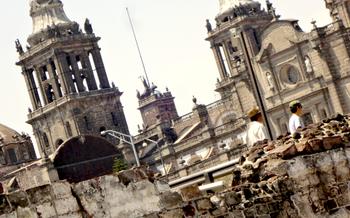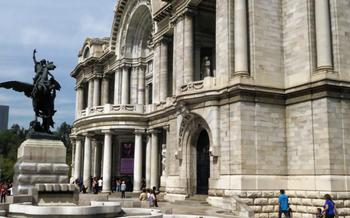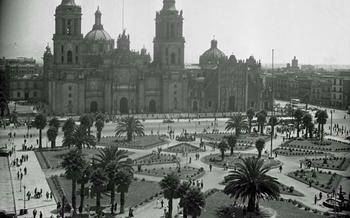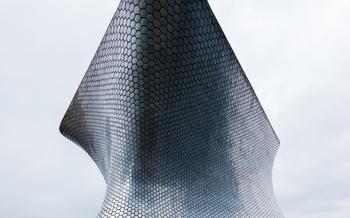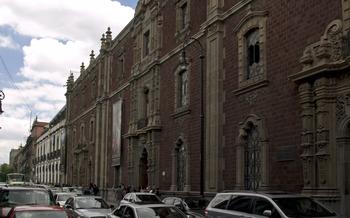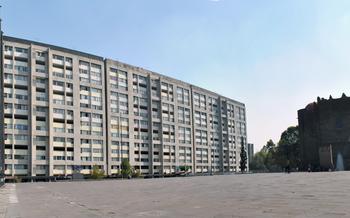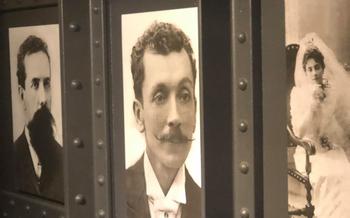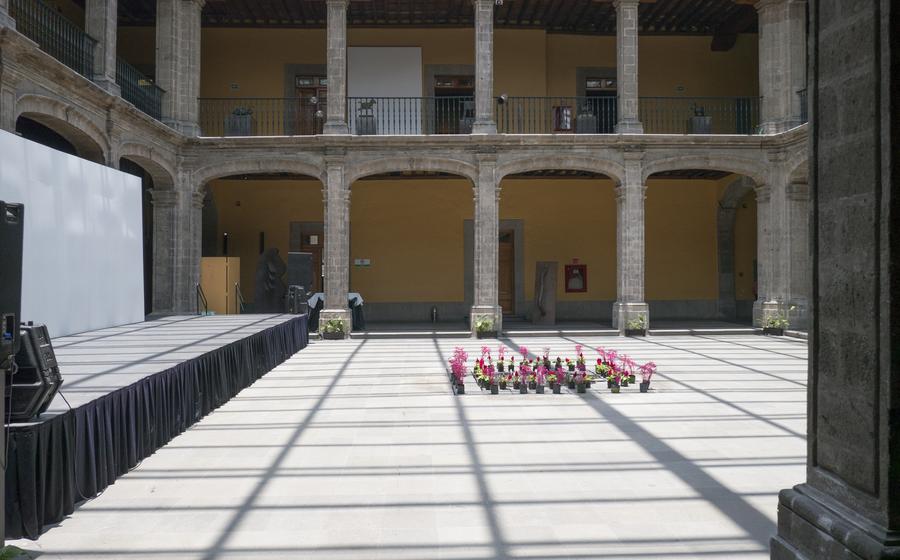
Museo de la SHCP
- Museo de la SHCP: A Hidden Gem in Mexico City
- History of the Museo de la SHCP
- Location and Getting There
- Hours of Operation and Guided Tours
- Permanent Collection
- Temporary Exhibitions
- Architecture and Design of the Building
- Museum Shop and Bookstore
- Accessibility for Visitors with Disabilities
- Photography and Videography
- Food and Beverage Options
- Events and Programs
- Family-Friendly Activities
- Sustainability and Environmental Initiatives
- Insider Tip
Museo de la SHCP: A Hidden Gem in Mexico City
Nestled in the heart of Mexico City's historic center, the Museo de la SHCP (Museo de la Secretaría de Hacienda y Crédito Público) is a hidden gem that offers a fascinating glimpse into the world of finance and economics. Dedicated to preserving and showcasing the history of Mexico's financial system, the museum houses a vast collection of artifacts, documents, and artworks that tell the story of the country's economic development. Whether you're a history buff, an art enthusiast, or simply curious about the world of finance, the Museo de la SHCP is a must-visit destination.
Why is it worth visiting?
The Museo de la SHCP is worth visiting for several reasons. First, it offers a unique perspective on Mexico's history. Through its collection of artifacts and documents, the museum tells the story of the country's economic development from the pre-Hispanic era to the present day. Second, the museum houses a number of valuable and rare artworks, including paintings, sculptures, and engravings. These works of art provide a glimpse into the cultural and artistic heritage of Mexico. Third, the museum is housed in a beautiful historic building that is worth seeing in its own right. The building was originally constructed in the 18th century and has been carefully restored to its former glory.
What are the highlights of the museum's collection?
Some of the highlights of the Museo de la SHCP's collection include:
- A collection of pre-Hispanic artifacts, including coins, jewelry, and tools, that provide a glimpse into the economic system of ancient Mexico.
- A collection of colonial-era documents, including tax records, ledgers, and maps, that document the development of Mexico's economy under Spanish rule.
- A collection of 19th-century paintings and engravings that depict the economic and social changes that occurred in Mexico during this period.
- A collection of 20th-century photographs that document the construction of Mexico's modern financial system.
How much does it cost to enter?
Admission to the Museo de la SHCP is free of charge.
History of the Museo de la SHCP
The Museo de la SHCP, 1981, under the initiative of the then Secretary of Finance, David Ibarra Muñoz. The museum was established as a means to preserve and showcase the historical and cultural heritage of Mexico's financial system, which dates back to the colonial era.
The building that houses the museum, located at the corner of Madero and Monte de Piedad streets in Mexico City's historic center, was originally constructed in the 16th century as the Palacio de los Condes de Heras y Soto. Over the years, the building has undergone several renovations and expansions, adapting to various uses, including serving as the headquarters of the National Pawn House and the Ministry of Finance.
In 1981, the building was designated as the home of the Museo de la SHCP, and it underwent extensive renovations to adapt it to its new purpose. The museum opened its doors to the public on September 29, 1981, with a collection of over 3,000 pieces related to Mexico's financial history.
Since its inauguration, the Museo de la SHCP has continued to grow and evolve, expanding its collection and offering a variety of educational programs and exhibitions to promote awareness of Mexico's financial heritage.
Location and Getting There
The Museo de la SHCP is conveniently located in the historic center of Mexico City, at the address of Calle de la Moneda 3, Colonia Centro. To get there using public transportation, you can take the metro to the Zócalo station (Line 2) and walk for about 5 minutes. Alternatively, you can take a bus or taxi to the Zócalo and walk from there.
If you are driving, there is limited paid parking available on the streets surrounding the museum. However, it is important to note that the historic center of Mexico City is a restricted traffic zone, so it is recommended to check the regulations before driving in the area.
In addition to the Museo de la SHCP itself, there are several other attractions and landmarks nearby that you can combine with your visit. These include the Templo Mayor, the Palacio Nacional, the Metropolitan Cathedral, and the Zócalo, which is the main square of Mexico City.
Hours of Operation and Guided Tours
The Museo de la SHCP is open to the public from Tuesday to Sunday, from 10:00 am to 5:00 pm. It is closed on Mondays and major holidays. Guided tours are available in both Spanish and English, and they are included in the entrance fee. Tours typically last about an hour and provide visitors with a deeper understanding of the museum's collection and history. To book a guided tour, visitors can either call the museum in advance or sign up at the front desk on the day of their visit.
Permanent Collection
The Museo de la SHCP's permanent collection is a treasure trove of Mexican art and history. The collection spans from pre-Columbian artifacts to modern masterpieces, providing a comprehensive overview of the country's rich cultural heritage. Highlights include a stunning collection of pre-Hispanic sculptures, including a colossal Olmec head, as well as a rare collection of colonial-era paintings and manuscripts. The museum also houses a significant collection of Mexican folk art, including colorful and intricate bordados (embroideries), ceramics, and textiles. Visitors can also admire works by renowned Mexican artists such as Diego Rivera, Frida Kahlo, and José Clemente Orozco, whose powerful murals grace the walls of the museum's main hall. The collection is displayed in a series of thematic galleries, allowing visitors to explore different periods and movements in Mexican art history. Whether you are interested in ancient civilizations, colonial art, or modern masterpieces, the Museo de la SHCP's permanent collection is sure to impress and inspire.
Temporary Exhibitions
Yes, the Museo de la SHCP hosts temporary exhibitions in addition to its permanent collection. These exhibitions typically showcase a variety of themes, including historical periods, artistic movements, and contemporary art. The museum collaborates with other institutions and organizations to bring in a diverse range of exhibitions that appeal to a wide audience.
The temporary exhibitions change on a regular basis, allowing the museum to present fresh and exciting content to its visitors. The frequency of the changes varies depending on the nature of the exhibition and the availability of works of art. Some exhibitions may run for several months, while others may be shorter in duration.
There is usually an additional charge to visit the temporary exhibitions, but the cost is typically quite reasonable. This fee helps to cover the expenses associated with acquiring and displaying the artworks, as well as the costs of marketing and promotion.
By offering temporary exhibitions, the Museo de la SHCP is able to provide its visitors with a dynamic and ever-changing experience. These exhibitions complement the permanent collection and allow the museum to explore new themes and perspectives, while also attracting new audiences.
Architecture and Design of the Building
The Museo de la SHCP is housed in a stunning 19th-century neoclassical building that was originally designed as the headquarters of the Secretariat of Finance and Public Credit. The building's grand facade features intricate carvings, ornate balconies, and a stately entrance that hints at the treasures within.
The architect responsible for the design of the building was Antonio Rivas Mercado, a prominent Mexican architect who is also known for his work on the Palacio de Bellas Artes. Rivas Mercado drew inspiration from European classical architecture, particularly the Italian Renaissance, when designing the Museo de la SHCP.
The building's interior is just as impressive as its exterior, with soaring ceilings, marble floors, and elegant chandeliers. The museum's collection is displayed in a series of interconnected galleries, each with its own unique character.
Over the years, the building has undergone several renovations and expansions to accommodate the growing collection and the increasing number of visitors. However, the building's original architectural features have been carefully preserved, ensuring that the Museo de la SHCP remains a testament to Mexico's rich history and cultural heritage.
Museum Shop and Bookstore
The Museo de la SHCP has a well-stocked gift shop where you can purchase a variety of souvenirs, books, and reproductions of the museum's collection. The shop is located on the ground floor of the museum and offers a wide range of items, including books on Mexican history and culture, postcards, magnets, jewelry, and handicrafts. The prices are reasonable and there are a few exclusive items and limited-edition products available. The shop is a great place to pick up a unique gift or souvenir to remember your visit to the museum. If you are on a tight budget, you can also find a few free items, such as brochures and postcards, at the information desk.
Accessibility for Visitors with Disabilities
The Museo de la SHCP is committed to ensuring that all visitors, including those with disabilities, have a positive and enjoyable experience. The museum is wheelchair accessible, and there are ramps and elevators to all floors. Visitors with disabilities can also take advantage of the museum's audio guide, which is available in Spanish and English and includes descriptive audio for visitors who are blind or visually impaired. Designated parking spaces for visitors with disabilities are available nearby, and there are discounted admission rates for visitors with disabilities and their companions.
Photography and Videography
The Museo de la SHCP is generally quite accommodating when it comes to photography and videography. Visitors are allowed to take pictures and videos for personal use in most areas of the museum. However, there are a few restrictions to be aware of.
Restrictions: - Flash photography is prohibited in all of the museum's galleries. This is to protect the artwork from damage. - Tripods and other photography equipment are not allowed in the galleries. This is to prevent damage to the artwork and to ensure that other visitors are not obstructed. - Photography and videography are not allowed in the museum's temporary exhibition spaces. This is to protect the privacy of the artists and to ensure that the works of art are not damaged.
If you have any questions about the museum's photography and videography policy, please feel free to ask a member of the museum staff.
Food and Beverage Options
The Museo de la SHCP does not offer a café or restaurant on-site, but there are several dining options within walking distance of the museum. Visitors can choose from a variety of restaurants, cafes, and food trucks that cater to different tastes and budgets.
For a quick and casual meal, visitors can head to the nearby Mercado de San Juan, a traditional Mexican market that offers a wide range of street food and local delicacies. There are also a number of popular restaurants in the surrounding area, including La Casa de las Sirenas, known for its seafood dishes, and El Cardenal, a classic Mexican restaurant that serves traditional cuisine in a beautiful setting.
For a more leisurely dining experience, visitors can head to the nearby Condesa neighborhood, which is known for its vibrant culinary scene. There are a number of trendy restaurants and bars in the area, offering everything from international cuisine to fine dining.
It is important to note that outside food and beverages are not allowed inside the museum, so visitors are encouraged to enjoy their meals before or after their visit.
Events and Programs
Throughout the year, the Museo de la SHCP hosts a variety of special events and programs that are designed to engage and educate visitors of all ages. These events may include workshops, lectures, concerts, film screenings, and more. The museum's website and social media channels are the best ways to find out about upcoming events and programs. Some events may require reservations or registration in advance, while others are open to the public on a first-come, first-served basis. There may be a fee to participate in some events, but many are offered free of charge. Whether you're interested in learning more about Mexican history and culture, enjoying a musical performance, or simply having a fun and educational day out, be sure to check the museum's calendar of events before your visit.
Family-Friendly Activities
The Museo de la SHCP is a great place for families with children. The museum offers a variety of interactive exhibits and activities that are designed to appeal to kids of all ages. For example, there is a hands-on exhibit where kids can learn about the history of money, and a virtual reality experience that lets them explore the ancient ruins of Mexico. The museum also hosts regular family-friendly events, such as workshops, storytelling sessions, and scavenger hunts.
In addition to the interactive exhibits and events, the Museo de la SHCP also offers a number of amenities that make it easy for families to visit the museum. For example, there are strollers available for rent, and the museum has a designated family restroom. The museum also offers a discount for families, and children under 6 years old are admitted free.
If you are looking for a fun and educational activity for your family, the Museo de la SHCP is a great option. With its interactive exhibits, family-friendly events, and amenities, the museum is sure to provide a memorable experience for everyone in your family.
Sustainability and Environmental Initiatives
The Museo de la SHCP is committed to sustainability and environmental protection. The museum has implemented several initiatives to reduce its carbon footprint, including using renewable energy sources, recycling and composting, and reducing water consumption. The museum also has several exhibits and programs that focus on environmental issues, such as climate change and biodiversity loss. Visitors can learn about sustainability and environmental protection through these exhibits and programs, and they can also take part in activities that help the museum reduce its environmental impact.
Insider Tip
If you're passionate about history and finance, be sure to check out the Museo de la SHCP's special exhibitions. These temporary exhibits often focus on specific themes or periods in financial history and often feature rare artifacts and documents that are not on display in the permanent collection. Past exhibitions have explored topics such as the history of banking in Mexico, the evolution of currency, and the role of finance in economic development. These exhibitions are a great way to learn more about the fascinating history of finance and its impact on our world.
